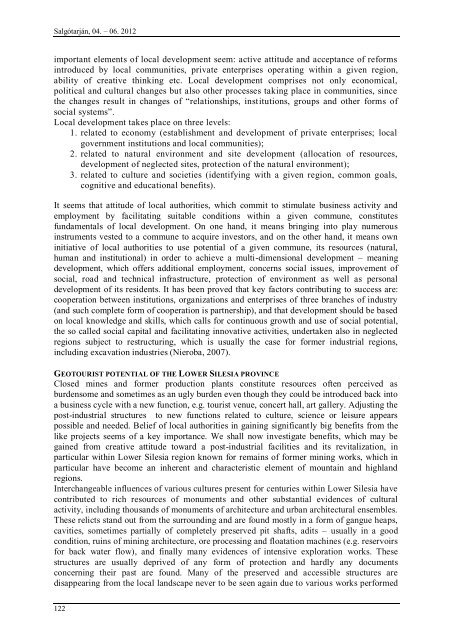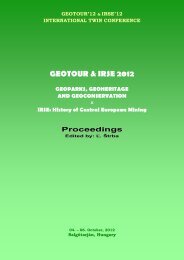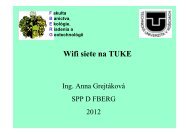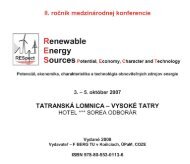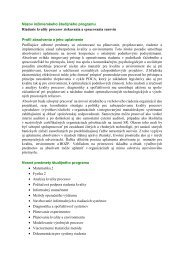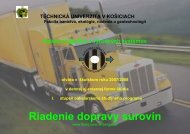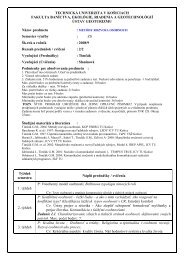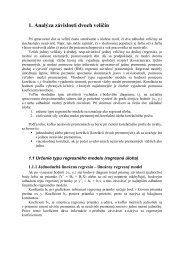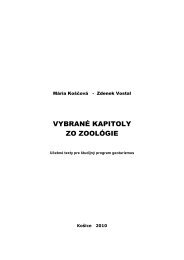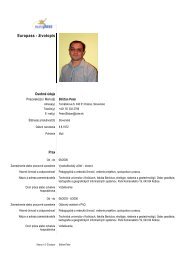GEOTOUR & IRSE 2012.pdf - Fakulta BERG - TUKE
GEOTOUR & IRSE 2012.pdf - Fakulta BERG - TUKE
GEOTOUR & IRSE 2012.pdf - Fakulta BERG - TUKE
You also want an ePaper? Increase the reach of your titles
YUMPU automatically turns print PDFs into web optimized ePapers that Google loves.
Salgótarján, 04. – 06. 2012<br />
important elements of local development seem: active attitude and acceptance of reforms<br />
introduced by local communities, private enterprises operating within a given region,<br />
ability of creative thinking etc. Local development comprises not only economical,<br />
political and cultural changes but also other processes taking place in communities, since<br />
the changes result in changes of “relationships, institutions, groups and other forms of<br />
social systems”.<br />
Local development takes place on three levels:<br />
1. related to economy (establishment and development of private enterprises; local<br />
government institutions and local communities);<br />
2. related to natural environment and site development (allocation of resources,<br />
development of neglected sites, protection of the natural environment);<br />
3. related to culture and societies (identifying with a given region, common goals,<br />
cognitive and educational benefits).<br />
It seems that attitude of local authorities, which commit to stimulate business activity and<br />
employment by facilitating suitable conditions within a given commune, constitutes<br />
fundamentals of local development. On one hand, it means bringing into play numerous<br />
instruments vested to a commune to acquire investors, and on the other hand, it means own<br />
initiative of local authorities to use potential of a given commune, its resources (natural,<br />
human and institutional) in order to achieve a multi-dimensional development – meaning<br />
development, which offers additional employment, concerns social issues, improvement of<br />
social, road and technical infrastructure, protection of environment as well as personal<br />
development of its residents. It has been proved that key factors contributing to success are:<br />
cooperation between institutions, organizations and enterprises of three branches of industry<br />
(and such complete form of cooperation is partnership), and that development should be based<br />
on local knowledge and skills, which calls for continuous growth and use of social potential,<br />
the so called social capital and facilitating innovative activities, undertaken also in neglected<br />
regions subject to restructuring, which is usually the case for former industrial regions,<br />
including excavation industries (Nieroba, 2007).<br />
<strong>GEOTOUR</strong>IST POTENTIAL OF THE LOWER SILESIA PROVINCE<br />
Closed mines and former production plants constitute resources often perceived as<br />
burdensome and sometimes as an ugly burden even though they could be introduced back into<br />
a business cycle with a new function, e.g. tourist venue, concert hall, art gallery. Adjusting the<br />
post-industrial structures to new functions related to culture, science or leisure appears<br />
possible and needed. Belief of local authorities in gaining significantly big benefits from the<br />
like projects seems of a key importance. We shall now investigate benefits, which may be<br />
gained from creative attitude toward a post-industrial facilities and its revitalization, in<br />
particular within Lower Silesia region known for remains of former mining works, which in<br />
particular have become an inherent and characteristic element of mountain and highland<br />
regions.<br />
Interchangeable influences of various cultures present for centuries within Lower Silesia have<br />
contributed to rich resources of monuments and other substantial evidences of cultural<br />
activity, including thousands of monuments of architecture and urban architectural ensembles.<br />
These relicts stand out from the surrounding and are found mostly in a form of gangue heaps,<br />
cavities, sometimes partially of completely preserved pit shafts, adits – usually in a good<br />
condition, ruins of mining architecture, ore processing and floatation machines (e.g. reservoirs<br />
for back water flow), and finally many evidences of intensive exploration works. These<br />
structures are usually deprived of any form of protection and hardly any documents<br />
concerning their past are found. Many of the preserved and accessible structures are<br />
disappearing from the local landscape never to be seen again due to various works performed<br />
122


